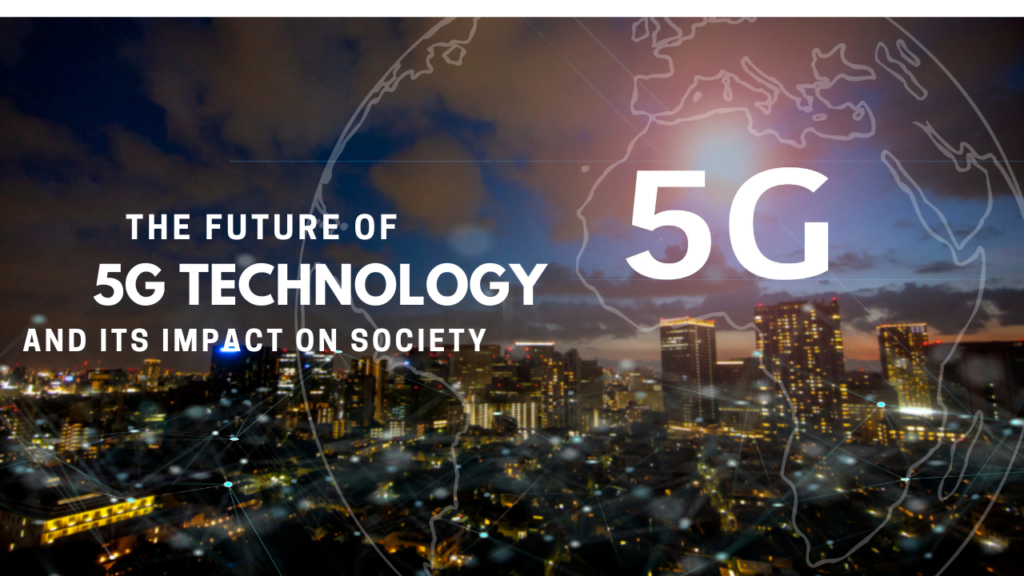Introduction to 5G Technology
5G technology is our mobile network’s latest and most advanced upgrade. The fifth generation of mobile technology has the potential to completely alter the way we communicate, work, and live. With its increased data transfer rates, lower latency, and faster network speeds, 5G has the ability to completely change industries and businesses, enabling new applications and services that were previously impossible. This article will explore the potential of 5G technology and how it could affect society. We’ll talk about the advantages of 5G, how it affects various industries, challenges in its implementation, and possible security and privacy concerns. Finally, we will look at how this technology could change the world in the future.
What is 5G Technology?
5G is the fifth generation of cellular network technology, designed to improve on the current 4G and earlier networks. It enables faster and more reliable data transmission, making it a groundbreaking technology that is set to revolutionize the way we live and work.
How is 5G Different from 4G and Previous Generations?
The primary difference between 5G and its predecessors is its speed and capacity. While 4G supports download speed of up to 100 Mbps, 5G has a maximum of 20 Gbps, which is 200 times faster than 4G. In addition, 5G supports more devices simultaneously and has reduced latency, which means there is less lag between transmitting and receiving data.
Advantages of 5G Technology
Enhanced Network Speed and Capacity:
5G delivers considerably faster network speeds and bandwidth capabilities, providing users with improved connectivity and faster download and upload speeds. This will help businesses and consumers process, upload, and download high-quality videos, images, and other data-heavy content.
Improved Latency and Reliability:
Another significant advantage of 5G technology is its improved latency and reliability. Latency is the time it takes for data to travel from the source to the destination; 5G offers a latency of 1 millisecond, much lower than the 50 milliseconds provided by 4G. This speed is essential for industries that rely on task automation, such as autonomous vehicles, drones, and robotics.
Higher Data Transfer Rates:
5G technology offers higher data rates than previous generations of cellular networks. The technology uses more advanced modulation schemes, which can support higher data rates of up to 20 Gbps when combined with wider bandwidths. This means that ultra-high-definition video can be streamed without buffering, healthcare professionals can transmit real-time medical data, and businesses can share data instantly.
Impact of 5G on Society
Revolutionizing Industries and Businesses:
One of the most significant impacts of 5G technology will be on industries and businesses. The technology will enable companies to improve their operations, increase productivity, and create new revenue streams. 5G will also revolutionize industries such as transportation, manufacturing, and logistics by implementing 5G-enabled autonomous vehicles, drones for delivery, and smart factories.
Transforming Healthcare Industry:
The healthcare industry is poised for massive change with 5G technology. Telemedicine services will become more prevalent, and remote patient monitoring will be more precise and efficient. Healthcare specialists will be able to perform surgeries remotely because to 5G’s low latency and fast data transfer, enabling patients in rural locations to receive the same high-quality care as those residing in urban areas.
Impact on Entertainment Industry:
By enabling faster and more dependable streaming of high-quality video, 5G technology is poised to revolutionise the entertainment sector. This will undoubtedly lead to more realistic virtual reality experiences, immersive gaming, and the ability to broadcast films and live events in real time without being reliable on a cable connection.
Internet of Things (IoT) and 5G
Role of 5G Technology in IoT
5G technology will be pivotal in developing the Internet of Things (IoT). It will provide networks with the speed and bandwidth to support massive data transfer rates between IoT devices. This will allow businesses to implement more intelligent and more efficient systems, enabling them to operate more efficiently, save time, and reduce costs.
How 5G Will Improve IoT Devices and Applications
5G networks will enable IoT devices to communicate with each other and the cloud with faster speed and lower latency. This will result in more responsive devices and a reduction in data transfer delays, allowing for quicker data processing and analysis. Ultimately, 5G technology will make it possible to create more advanced IoT applications, leading to smarter homes, cities, and industries.
Challenges of 5G Implementation
The implementation of 5G technology has its challenges. The deployment of 5G presents significant infrastructure and network deployment challenges. The new technology requires a dense network of small cells, which are placed closer together than traditional cell towers. This requires a significant investment in infrastructure to support the deployment of 5G.
Another challenge is the issues surrounding spectrum and standards. The radio spectrum is a limited resource, and as more devices are connected to the network, the demand for spectrum increases. In addition, there are different standards for 5G, which can cause interoperability issues between vendors.
Infrastructure and Network Deployment Challenges
Implementing 5G technology requires deploying a dense network of small cells, which is a significant investment in infrastructure. The small cells must be placed much closer together than traditional cell towers, which require many installations. This is especially challenging in urban areas with limited locations for small-cell installation.
Issues Regarding Spectrum and Standards
The radio spectrum is a limited resource, and its demand is increasing. As more devices are connected to the network, the demand for spectrum increases, causing potential shortages. In addition, there are different standards for 5G, which can cause interoperability issues between vendors.
Security and Privacy Concerns with 5G Technology
New security and privacy concerns come with increased connectivity and faster speeds of 5G. There are potential security threats with the 5G network, including vulnerabilities in the hardware and software. Additionally, the increased amount of data being transmitted can make the network more susceptible to cyber-attacks.
Furthermore, as more devices are connected to the network, there are potential privacy and data protection issues. The data transmitted over the network can be intercepted, which could lead to data breaches or unauthorized access to personal information.
Potential Security Threats with 5G
The new technology of 5G presents potential security threats with the increased amount of data being transmitted. The network can be more susceptible to cyber-attacks, and there are vulnerabilities in the hardware and software.
Privacy and Data Protection Issues
With more devices connected to the network, there are potential privacy and data protection issues. Personal information can be intercepted when transmitted over the web, leading to data breaches or unauthorized access to confidential information.
Future of 5G Technology and Possibilities
The future of 5G technology is exciting, and many potential applications and use cases exist. The increased connectivity and faster speeds of 5G will enable new technologies, such as autonomous vehicles and virtual reality.
Additionally, technological advancements and innovations are being made in the 5G network, which will only increase the capabilities and possibilities of the technology.
Possible Applications and Use Cases of 5G
The increased connectivity and faster speeds of 5G will enable new technologies, such as autonomous vehicles and virtual reality. This could revolutionize industries like healthcare, transportation, and entertainment.
Technological Advancements and Innovations in 5G
Technological advancements and innovations are being made in the 5G network, such as network slicing, which will increase the capabilities and possibilities of the technology.
Conclusion and Summary
The implementation of 5G technology presents significant infrastructure and network deployment challenges, as well as issues surrounding spectrum and standards. In addition, there are security and privacy concerns with the increased connectivity and faster speeds of 5G.
However, the future of 5G is exciting, with many potential applications and use cases, such as autonomous vehicles and virtual reality. Technological advancements and innovations in the 5G network will only increase the capabilities and possibilities of the technology. In conclusion, the future of 5G technology is bright and promising. 5G will move us closer to a more connected and technologically sophisticated society since it has the potential to alter businesses and industries. To guarantee that it is implemented securely and successfully, it is crucial to address the difficulties and worries associated to its deployment. To fully benefit from this technology as we progress towards a 5G-enabled future, it is essential to concentrate on innovation, teamwork, and responsible deployment.
Frequently Asked Questions (F.A.Q.)
What is 5G technology, and how is it different from previous generations?
The fifth generation of mobile technology, or 5G, promises better data transfer rates, lower latency, and quicker network speeds than earlier generations. Unlike its predecessors, 5G uses higher frequency radio waves that can carry more data, enabling faster and more reliable connections.
What are the benefits of 5G technology?
A few advantages of 5G technology include increased data transfer speeds, better latency and dependability, and faster network speed and capacity.Additionally, it may open the door for brand-new services and applications like telemedicine, smart cities, and driverless vehicles.
What are some of the challenges of implementing 5G?
Implementing 5G has its challenges. One of the biggest challenges is the need for extensive infrastructure and network deployment, including installing small cells and fiber-optic cables. There are also concerns about spectrum allocation, as 5G requires much more than previous generations. Additionally, there are issues related to international standards and compatibility, as different regions may have different 5G deployment plans and frequencies.
What are the security and privacy concerns with 5G technology?
Similar to new technologies in general, 5G may raise security and privacy issues. The use of higher-frequency radio waves, for instance, might make 5G networks more susceptible to obfuscation and online attacks. As 5G permits the acquisition of enormous volumes of data from linked devices, there are also worries regarding the collection and use of personal data. Strong security controls must be put in place, and 5G networks must be built with privacy in mind, to allay these worries.



